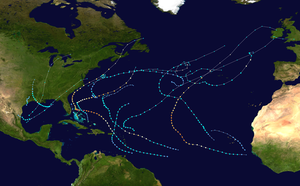| Timeline of the 2019 Atlantic hurricane season | |||||
|---|---|---|---|---|---|
 Season summary map | |||||
| Season boundaries | |||||
| First system formed | May 20, 2019 | ||||
| Last system dissipated | November 25, 2019 | ||||
| Strongest system | |||||
| Name | Dorian | ||||
| Maximum winds | 185 mph (295 km/h) (1-minute sustained) | ||||
| Lowest pressure | 910 mbar (hPa; 26.87 inHg) | ||||
| Longest lasting system | |||||
| Name | Dorian | ||||
| Duration | 14.25 days | ||||
| |||||
The 2019 Atlantic hurricane season was an event in the annual tropical cyclone season in the north Atlantic Ocean. It was the fourth consecutive above-normal Atlantic hurricane season.[a][2] The season officially began on June 1, 2019, and ended on November 30, 2019. These dates, adopted by convention, historically describe the period in each year when most tropical systems form.[3] However, storm formation is possible at any time of the year, as demonstrated in 2019 by the formation of the season's first named storm, Subtropical Storm Andrea, on May 20. The final storm of the season, Tropical Storm Sebastien, transitioned to an extratropical cyclone on November 25.
The National Oceanic and Atmospheric Administration's 2019 seasonal outlook called for 10–17 named storms, including 5–9 hurricanes and 2–4 major hurricanes. Altogether, the season produced 18 named storms, including six hurricanes of which three intensified into major hurricanes.[b][2] Two major hurricanes, Dorian and Lorenzo, became Category 5 storms, causing the season to become the fourth consecutive with at least one Category 5 hurricane. Dorian inflicted catastrophic damage across the Bahamas. The hurricane killed at least 70 people and caused at least US$3.4 billion in damage, making it the costliest hurricane in the country's history. While Lorenzo did not affect land as a Category 5 hurricane, it caused US$367 million in damage and killed 19, with over half of the deaths being attributed to the sinking of a tugboat known as the Bourbon Rhode.[5][6][7] In March 2021, the name Dorian was retired from reuse in the North Atlantic by the World Meteorological Organization.[8]
This timeline documents tropical cyclone formations, strengthening, weakening, landfalls, extratropical transitions, and dissipations during the season. It includes information that was not released throughout the season, meaning that data from post-storm reviews by the National Hurricane Center, such as a storm that was not initially warned upon, has been included.
By convention, meteorologists use one time zone when issuing forecasts and making observations: Coordinated Universal Time (UTC), and also use the 24-hour clock (where 00:00 = midnight UTC).[9] The National Hurricane Center uses both UTC and the time zone where the center of the tropical cyclone is currently located. The time zones utilized (east to west) prior to 2020 were: Atlantic, Eastern, and Central.[10] In this timeline, all information is listed by UTC first with the respective regional time included in parentheses. Additionally, figures for maximum sustained winds and position estimates are rounded to the nearest 5 units (knots, miles, or kilometers), following the convention used in the National Hurricane Center's products. Direct wind observations are rounded to the nearest whole number. Atmospheric pressures are listed to the nearest millibar and nearest hundredth of an inch of mercury.
- ^ "Background Information: North Atlantic Hurricane Season". College Park, Maryland: NOAA Climate Prediction Center. Retrieved August 6, 2020.
- ^ a b Gaches, Lauren (November 26, 2019). "Active 2019 Atlantic hurricane season comes to an end". Washington, D.C.: National Oceanic and Atmospheric Administration. Retrieved June 29, 2020.
- ^ Dorst, Neal (June 1, 2018). "Hurricane Season Information". Frequently Asked Questions About Hurricanes. Miami, Florida: NOAA Atlantic Oceanographic and Meteorological Laboratory. Retrieved June 29, 2020.
- ^ "Saffir-Simpson Hurricane Wind Scale". Miami, Florida: National Hurricane Center. Retrieved August 6, 2020.
- ^ Karimi, Faith; Thornton, Chandler (September 12, 2019). "1,300 people are listed as missing nearly 2 weeks after Hurricane Dorian hit the Bahamas". CNN. Retrieved July 10, 2020.
- ^ Miller, Kimberly (September 30, 2019). "Hurricane Lorenzo should never have made it to a Cat 5, but it did". The Palm Beach Post. West Palm Beach, Florida. Retrieved July 10, 2020.
- ^ Fedschun, Travis (2019-09-30). "Hurricane Lorenzo sinks tugboat carrying 14 crew members; at least 1 found dead at sea, 3 rescued". Fox News. Retrieved 2021-03-21.
- ^ "WMO Hurricane Committee retires tropical cyclone names and ends the use of Greek alphabet". Geneva, Switzerland: World Meteorological Organization. March 17, 2021. Archived from the original on December 18, 2023. Retrieved April 29, 2021.
- ^ "Understanding the Date/Time Stamps". Miami, Florida: NOAA National Hurricane Center. Retrieved July 10, 2020.
- ^ "Update on National Hurricane Center Products and Services for 2020" (PDF). Miami, Florida: National Hurricane Center. April 20, 2020. Retrieved May 17, 2020.
Cite error: There are <ref group=lower-alpha> tags or {{efn}} templates on this page, but the references will not show without a {{reflist|group=lower-alpha}} template or {{notelist}} template (see the help page).